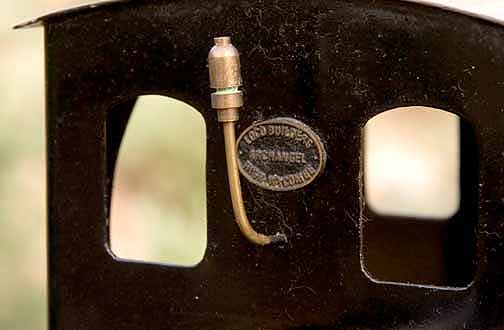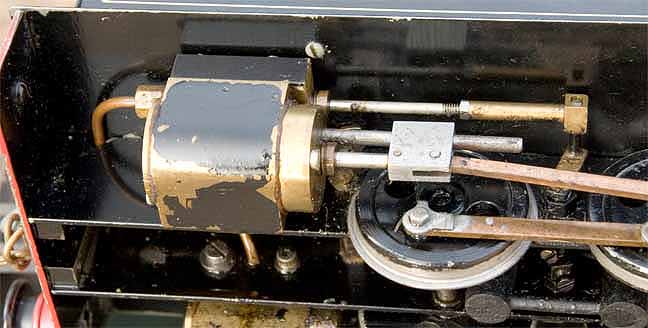
Back to Loco of the Month homepage
Back to Sidestreet Bannerworks
.
May 2008
Archangel Hercules
by Marc Horovitz

Archangel locomotives have been featured several times in these pages, as Archangel Models is one of my favorite manufacturers. The company's products range from crude to sublime. Generally speaking, the lower-end production models run toward the former and the upper end and one-offs lean more toward the latter. Stewart Browne, the company's owner, produced an astonishing number of locomotives over the years. No one knows how many -- including Stewart.
This month's offering is called Hercules. It is a boxy 0-6-0T that, in many ways, resembles the company's Sgt. Murphy engines. The primary cosmetic difference is the windows, which on the Sgt. Murphys are round and on Hercules are rectangular with rounded corners and arched tops. The primary mechanical difference, which is significant, is that Hercules has two D-valve cylinders outside the frames, whereas Sgt. Murphy has but one, inside. Thus, Hercules is a more fully realized locomotive and has the attraction of being self starting.
Reversing is via Archangel's usual slip eccentrics on the rear axle. Motion is brought to the outside valves atop the cylinders by rocker arms set into the frames. The boiler is a pot type, fired by a three-wick burner. The fuel tank resides beneath the cab floor. There's a filler pipe and overflow on the left side of the tank.
Boiler fittings include a safety valve under the steam dome; a throttle valve, the handle of which projects through the cab's back sheet for easy access; a pressure gauge and a whistl (attached to the same line from the boiler); and a blowdown valve. The whistle, unsupported except for the steam line to which it's attached, has a screw-type valve of dubious utility.
Side tanks are Archangel's usual solid chunks of aluminum. The locomotive is finished in gloss black paint neatly lined in white. The engine has seen some use and paint is flaking off in places, particularly from the cab floor. Buffers are Archangel's standard nylon turnings (so you can pick up a hot engine) and, typically, one shows signs of a fuel-tank fire.
The run
Run day was cool and breezy. I prepared the engine in the usual way and lit the wicks. I opened the screw valve on the whistle to let me know when steam was up. After a while it started hissing, so I closed the valve. In a few minutes more there was 20 pounds on the clock.
I opened the throttle pretty wide. After a minimum of sputtering the engine took off. I closed the throttle so that the engine was running at a reasonable pace. Hercules, like all of Stewart Browne's engines of this sort, is easily controllable and sweet running. When the safety valve lifted abruptly for the first time, it blew the heavy, solid-brass dome clear off the engine!
After running light for a few laps, I tied on a train of three Accucraft ballast wagons, full of ballast. This was a fairly heavy train, which gave the engine something useful to do.
With the train in tow, the exhaust beats were now distinctly audible, whereas before they could not be heard. I found the engine to be pretty thirsty, requiring fairly frequent stops for fuel. I suspect that the wicks could be packed a little tighter, which might ease this problem. I had to keep a close eye on the fuel level as, if it got too low, the fire would go out.
Altogether, the run was most satisfactory on this crisp spring day. Today's session reinforced my reasons for favoring Archangel locomotives.
|
|
|
| Builder | Archangel Models (UK) |
| Date built | 1981 |
| Gauge | 32mm |
| Scale | 16mm |
| Boiler | Pot |
| Fittings | Safety valve, pressure gauge, throttle, whistle, blowdown valve |
| Fuel | Alcohol |
| Blow-off pressure | 50 psi |
| Cylinders | Two, double-acting D-valve |
| Reversing gear | Slip eccentrics |
| Lubricator | Displacement |
| Weight | 6 pounds, 0 ounces |
| Dimensions | Length, 11-1/8": width, 4"; height, 6-1/2" |



Coming off the same steam line is the lead to the pressure gauge. The knob below and to the left of the whistle is the blowdown valve.
A short length of silicone tubing has been stuck on the fuel filler pipe to extend it away from the cab a little in case of fire. The overflow pipe is just to the right of it.





Back to Loco of the Month home page
Back to Sidestreet Bannerworks home page
This page and its contents
Copyright Sidestreet Bannerworks, 2008
.